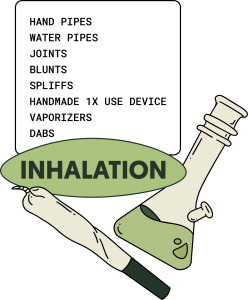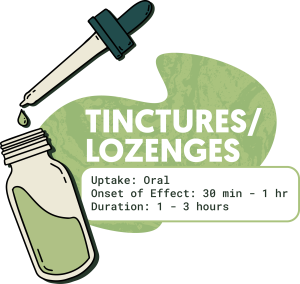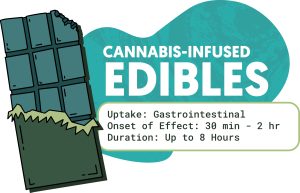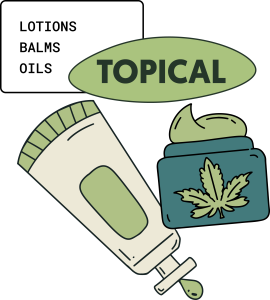Different Ways To Use Cannabis
There are many ways to consume cannabis, especially nowadays with recreational and medicinal use becoming more and more accepted. Walking into a dispensary and being overwhelmed with choices is quite common. Many cannabis brands and cultivation facilities are coming up with innovative ways to make and consume their products as cannabis research and technology advances. Learning how to consume cannabis products correctly will allow consumers to get the best bang for their buck and increase the product’s therapeutic potential.

Puff, Puff, Pass:
Inhalation is the most popular way to consume cannabis. When cannabinoids and terpenes are inhaled, they are passed directly into the bloodstream via the lungs, for fast acting relief of symptoms. Smoking and vaping are both forms of inhalation but differ in a number of ways.
Smoking cannabis is the most common form of inhalation. Smoke enters the lungs and is immediately absorbed and transported to the brain. You can smoke cannabis out of water pipes or bongs, hand pipes or bowls, joints, pre-rolls, blunts, etc. Smoking involves heating cannabis to the point of combustion, which occurs around 600-900℉.
Many people are concerned about the damage that smoking can cause to the lungs, however smoking cannabis is not as bad for the lungs as some people may think. One study conducted in 2012, published in The Journal of American Medical Association, found that smoking cannabis at a rate of one joint per day for as long as 7 years doesn’t seem to negatively affect lung function. Moreover, this same study found that smoking cannabis in moderation may actually improve lung function by giving the lungs and chest muscles a workout. The same lung-function tests were applied to tobacco and cigarette smokers, however the results were opposite – showing that tobacco smoke is associated with decreased lung function. While it would be an exaggeration to say that smoking cannabis is good for your lungs, it is fair to say that smoking cannabis is safer than smoking cigarettes or other tobacco products.
An alternative to smoking cannabis is vaping. Vaporizers work by heating cannabis flower or cannabis extract to a temperature at which the active ingredients boil off and form inhalable vapor. It is important to be aware that different cannabinoids and terpenes will vaporize at different temperatures. Most cannabis vaporizers will get as hot as 800℉, but it is recommended to set your vaporizer at a lower temperature (350-500℉) to preserve the terpenes and cannabinoids. 428℉ is the temperature at which the two cannabinoids with the highest boiling point (THCV and CBC) will vaporize. In general, cannabinoids will vaporize at temperatures between 315℉-430℉ while terpenes can vaporize at temperatures between 150℉-390℉. Understanding this can allow consumers to modify their experience by modulating terpene and cannabinoid vaporization by adjusting the temperature on their vape device. For example, the terpene pinene (promotes alertness) vaporizes at 311℉, THC vaporizes at 315℉, and the terpene myrcene (promotes sedating effects) vaporizes at 330℉. Vaping at a temperature around 315℉-320℉ would allow the user to experience the euphoric and uplifting effects from THC and pinene while avoiding the sedating effects of myrcene.
A convenient, discrete way to blaze.
There are many cannabis products and devices to choose from when it comes to vaping. The most common method–because of their discreteness and ease of use–are disposable vapes and vape cartridges. All vape cartridges are filled with cannabis concentrates, but the type of concentrate can vary between products. Cartridges can be filled with full spectrum extracts such as live resin or rosin, which contain all the cannabinoids and terpenes found in the cannabis plant for a better entourage effect. Rosin cartridges tend to be more expensive than live resin cartridges due to the solventless extraction method used to produce rosin. Most cartridges are filled with distillate oil. Most of the time, distillate oil contains only THC and lacks the other cannabinoids and terpenes. Terpenes from cannabis or other plants may be reintroduced into the distillate oil to improve flavor and effect.
The most common type of cartridge is the 510 thread cartridge, named after the 510mm thread on the bottom of the cartridge that connects to a battery. These cartridges are interchangeable with any battery that fits a 510 thread cartridge. There are cartridges that are manufactured to only work with one device, such as PAX Pods or Dart Pods, these types will not work with 510 thread batteries. Lastly, there are disposable vape pens that are single-use devices with the concentrate, battery and mouthpiece all in one. These disposable vapes require no charging and once the concentrate is depleted, the cartridges are no longer usable and can be discarded.
The rig.
Another common way to vaporize cannabis involves the use of a dab rig. Dab rigs work similarly to water bongs in that they have a neck, mouthpiece, water chamber, and percolator; however, rigs will have a wax banger rather than a bowl for flower. The empty banger is heated using a torch and the wax is applied using a “nail” or “dabber”. Once the wax is in the hot banger then the users can just inhale the vapor similarly to how they would hit a bong.
Nowadays, electronic dab rigs and nectar collectors exist for fast and convenient dabbing on-the-go. Electronic dab rigs and nectar collectors heat up using an electronic heating element rather than having to use a torch. E-rigs will still have a water chamber while nectar collectors look more similar to vape pens.
How to gauge my dose?
The dose one receives when smoking and vaping is difficult to determine and depends on the potency of the product, length of inhale, type of smoking or vaping device/technique, and temperature. The onset of effects from inhalation is almost immediate – between 5 and 10 minutes, and the effects can last anywhere from 2-4 hours. Cannabis concentrates are more potent than dried cannabis flower, so these products usually require a smaller dose to achieve the same effect. The rule of thumb is ”Start Low, Go Slow”, meaning that you should start with the lowest dose possible while keeping track of how you feel, then increasing the dose slowly until you reach the desired effect.
What are Edibles?
Edible products include any food, drink, or capsule/pill that contain cannabis. Edibles provide unique medicinal and recreational benefits when compared to smoking, like potency and duration–edibles are easier to accurately dose and have longer-lasting effects.
To make edibles, cannabis is first infused in a butter or oil mixture. Some examples of these infusions include cannabutter, cannabis coconut oil, cannabis cooking oil, and more. Raw cannabis contains THCA and CBDA, which are non-psychoactive acid forms of cannabinoids. These acid forms need to be heated (decarboxylated) to activate them for metabolism in the human digestive tract. Complete activation of cannabinoids, like THC and CBD, occurs at 220 degrees fahrenheit after 90 minutes. Once that process is completed, then comes the fun part – making the delicious edible by infusing cannabis oil into foods and baked goods such as brownies, cookies, salad dressings, soup broths, and more.
While it can be fun to make your own cannabis edibles at home, you can also buy edibles at a licensed provisioning center. There’s a wide range of cannabis edibles on the market right now, from gummies and chocolates, to seltzers and mints, to popcorn and pretzel sticks. Edibles may be infused with several different types of cannabis extract such as distillate oil, full spectrum live resin or solventless hash rosin. A benefit to buying edibles from a licensed provisioning center is that certain cannabinoids and terpenes can be specifically selected to modulate the consumer’s experience. For example, edibles infused with THC and THCV can be used to increase focus and boost your metabolism while edibles with THC and CBC would be great for reducing pain and inflammation.
How do I know how much to eat?
Edibles are notorious for having incredibly high potency; this is because when we consume them, our digestive systems and livers metabolize the THC into a more potent form; 4 times more potent than inhaled THC. This is also why the effects of edibles last significantly longer than a smoke sesh, vape hit, or dab. Eating a fatty meal before or with your edibles will help your body process and absorb the cannabinoids to increase their effect.
We’ve all known someone who has eaten too many edibles, or one that was just too strong, and had an unpleasant evening – that’s why it’s important to buy edibles from a provisioning center so you can consume the right dosage and ensure the best therapeutic experience. Every person metabolizes cannabis differently, so finding the right dose will be different for everyone. Rule of thumb is to start with a low dose and wait. The lowest dose available is usually around 2.5 mg of THC and can reach up to 200mg. The desired effect of edibles can take anywhere from 15 minutes to two hours, and is different for everyone.
Ratios are also important when looking at edible cannabis products. For example, an 8:1 CBD to THC ratio typically causes no psychoactive effects, while a 1:1 ratio of CBD and THC will typically cause psychoactive effects. THC is the cannabinoid responsible for producing psychoactive effects while other cannabinoids are beneficial for other therapeutic uses but are not intoxicating. Other cannabinoids like CBN, to help promote sleep; or CBG, to help reduce nausea and stimulate appetite may be found in edible products to increase medicinal benefits.
 How are sublingual forms of cannabis different from edibles?
How are sublingual forms of cannabis different from edibles?
Sublingual forms of cannabis include lozenges, suckers, tinctures, oils, strips, tablets, and sprays. These formulations are different from edibles because the cannabinoids are able to get into the bloodstream more quickly by avoiding the digestive tract and liver. Because the liver is avoided, the THC is not metabolized into a more potent form like with edibles. Many terpenes and cannabinoids may be more effective in this form because the heat of smoking and vaping renders them less effective, and avoiding the digestive tract and liver increases the products overall bioavailability.
Sublinguals are meant to be absorbed under the tongue.
The word sublingual comes from the Latin words “sub” and “lingua” which translates to “under the tongue”. Swallowing these products before giving them enough time to absorb under your tongue is quite a common mistake. Sublingual cannabis strips, while they may look like breath-freshening strips that you would place on your tongue, should be placed under the tongue for proper absorption. Tinctures also work better when the oil or alcohol is held under the tongue, rather than swallowed immediately or mixed in with food or drinks. The same goes with any other form of sublingual cannabis product. It takes about 30 minutes to an hour for the effects of sublingual cannabinoids to kick in and the effects can last anywhere from 1 to 3 hours depending on the dose and the person. The longer you leave the oil, spray, tablet, strip or tincture under your tongue, the faster and stronger the effect will be.
Topicals and Transdermals:
Topicals are cannabis-infused lotions, balms, and oils that are absorbed through the skin. This provides a localized treatment for pain and inflammation. Because topicals are non-intoxicating, they are often chosen by patients who desire the therapeutic benefits of cannabis without the psychoactive effects usually associated with the plant. Topicals can contain other ingredients outside of just cannabis, such as essential oils and terpenes that are known for their own unique therapeutic effects.
Topicals are most often used to treat localized pain relief, muscle soreness, tension, and inflammation. The anti-inflammatory effects of many cannabinoids make topicals very soothing to the skin and can help treat skin conditions such as eczema and psoriasis. Topical formulations with CBD in combination with terpenes like limonene, linalool, and pinene may work as an acne treatment due to their antibacterial properties and CBD’s ability to reduce the overproduction of sebum in the skin, which is linked to acne.
What are the Different Kinds of Topicals?
While most topicals come in the form of creams and balms, patients have demanded more of a variety, and the industry hasn’t disappointed. Topicals now exist in the following forms:
Salves
Creams
Oils
Lotions
Sprays
Patches (transdermal)
Bath products (bath salts, bath bombs)
How do Transdermals differ from topicals?
Transdermal patches and lotions deliver cannabinoids through the skin and into the underlying tissue, joints and bloodstream while topical creams and lotions remain on the skin’s surface like sunscreen and insect repellent. The formulation of transdermal products requires the use of a carrier (ethosomes) to help the cannabinoids and terpenes pass through the skin. Transdermal cannabis formulations can be useful in the treatment of neuropathic pain, nausea, vomiting, anorexia, and multiple sclerosis. While the majority of topicals are non-intoxicating, transdermal patches and lotions with high enough THC content can provide intoxicating effects since the cannabinoids may penetrate deep enough to enter the bloodstream.
Budtenders are there to help.
All of this information can be confusing to cannabis naive individuals or even “stoners” who have been using cannabis for ages. That being said, don’t be afraid to ask the budtenders for help if you need more clarification or recommendations. Doing your own research and making sure to ask for help when needed will ensure you’re getting the best bang for your buck!








